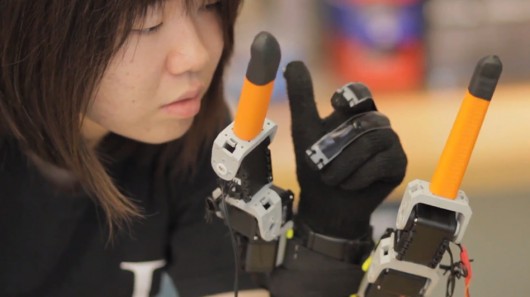
 Earlier
this month, we heard about an MIT project in which test subjects were equipped
with an extra set of robotic arms in order to help them perform tasks. While
the technology is certainly intriguing, some people might find the concept of a
four-armed cyborg to be a little ... much. If you're one of those people, then
you might be more comfortable with another ongoing MIT project. It's just aimed
at giving people two extra robotic fingers.
Earlier
this month, we heard about an MIT project in which test subjects were equipped
with an extra set of robotic arms in order to help them perform tasks. While
the technology is certainly intriguing, some people might find the concept of a
four-armed cyborg to be a little ... much. If you're one of those people, then
you might be more comfortable with another ongoing MIT project. It's just aimed
at giving people two extra robotic fingers.
Developed
by a team led by professor of engineering Harry Asada and grad student Faye Wu,
the "supernumerary robotic fingers" extend from either side of the
user's dominant hand, and are attached to a device that's worn around the
wrist.
The
idea behind them is that (among other things) they could allow users to perform
tasks that usually require two hands, using only one. As an example, the extra
fingers could grip a jar while the other fingers unscrewed its lid, or they
could hold an envelope down while the others slit it open – both of which have
already been demonstrated in the lab.
In
order to control the robotic fingers, the researchers analyzed the ways in
which movements of the hand's regular five fingers are coordinated. It was
noted that in a variety of grasping tasks, the fingers always defaulted to a
combination of two basic movements – coming together and twisting inwards.
This
led to the development of an algorithm that monitors the positions of the five
real fingers via a sensor-equipped glove, and moves the two extras accordingly.
Essentially, it's getting them to do what the user would expect them to, if
they really were part of the body.
So
far, their functions are limited to the grasping and releasing of objects.
Next, though, the team hopes to establish methods of controlling how much force
they apply, and getting them to adapt to the different grasping
"styles" of individual users.
Ultimately,
it is hoped that the technology could be streamlined and miniaturized to the
point that the extra fingers could lie folded up inside something like a
bracelet, and pop out to assist the user as needed.

 Previous page
Previous page Back to top
Back to top







